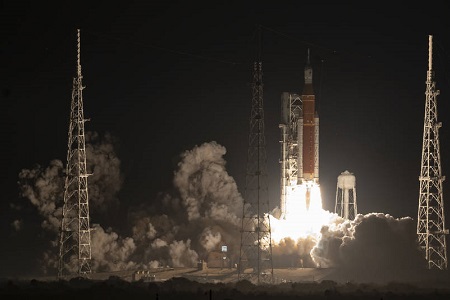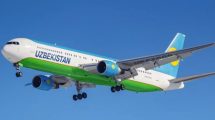
Following the launch of NASA’s Space Launch System (SLS), the agency’s Orion spacecraft is on its way to the Moon as part of the Artemis programme. Carrying an uncrewed Orion, SLS lifted off for its flight test debut on Wednesday, November 16, from Launch Pad 39B at NASA’s Kennedy Space Center in Florida.
The launch is the first leg of a mission in which Orion is planned to travel approximately 40,000 miles beyond the Moon and return to Earth over the course of 25.5 days. Known as Artemis I, the mission is a critical part of NASA’s Moon to Mars exploration approach, in which the agency explores for the benefit of humanity. It’s an important test for the agency before flying astronauts on the Artemis II mission.
NASA Administrator Bill Nelson said: “What an incredible sight to see NASA’s Space Launch System rocket and Orion spacecraft launch together for the first time. This uncrewed flight test will push Orion to the limits in the rigours of deep space, helping us prepare for human exploration on the moon and, ultimately, Mars.”
After reaching its initial orbit, Orion deployed its solar arrays and engineers began performing checkouts of the spacecraft’s systems.
Orion has separated from its upper stage and is on its outbound coast to the moon powered by its service module, which is the propulsive powerhouse provided by ESA (European Space Agency) through an international collaboration.
Jim Free, NASA deputy associate administrator for the Exploration Systems Development Mission Directorate, added: “It’s taken a lot to get here, but Orion is now on its way to the Moon. This successful launch means NASA and our partners are on a path to explore farther in space than ever before for the benefit of humanity.”
Over the next several hours, a series of 10 small science investigations and technology demonstrations, called CubeSats, will deploy from a ring that connected the upper stage to the spacecraft. Each CubeSat has its own mission that has the potential to fill gaps in our knowledge of the solar system or demonstrate technologies that may benefit the design of future missions to explore the Moon and beyond.
Orion’s service module will also perform the first of a series of burns to keep Orion on a course toward the Moon approximately eight hours after launch. In the coming days, mission controllers at NASA’s Johnson Space Center in Houston will conduct additional checkouts and course corrections as needed. Orion is expected to fly by the Moon on Nov. 21, performing a close approach of the lunar surface on its way to a distant retrograde orbit, a highly stable orbit thousands of miles beyond the Moon.
Mike Sarafin, Artemis I mission manager, stated: “The Space Launch System rocket delivered the power and performance to send Orion on its way to the Moon. With the accomplishment of the first major milestone of the mission, Orion will now embark on the next phase to test its systems and prepare for future missions with astronauts.”
Artemis I is supported by thousands of people around the world, from contractors who built Orion and SLS, and the ground infrastructure needed to launch them, to international and university partners, to small businesses supplying subsystems and components.
Through Artemis missions, NASA will land the first woman and the first person of colour on the surface of the Moon, paving the way for a long-term lunar presence and serving as a stepping stone for astronauts on the way to Mars.














Add Comment